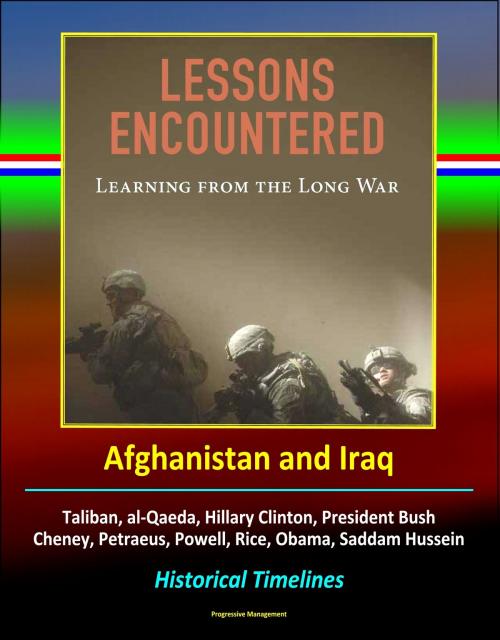Lessons Encountered: Learning from the Long War - Afghanistan and Iraq, Taliban, al-Qaeda, Hillary Clinton, President Bush, Cheney, Petraeus, Powell, Rice, Obama, Saddam Hussein, Historical Timelines
Nonfiction, History, Military| Author: | Progressive Management | ISBN: | 9781310829284 |
| Publisher: | Progressive Management | Publication: | November 1, 2015 |
| Imprint: | Smashwords Edition | Language: | English |
| Author: | Progressive Management |
| ISBN: | 9781310829284 |
| Publisher: | Progressive Management |
| Publication: | November 1, 2015 |
| Imprint: | Smashwords Edition |
| Language: | English |
Professionally converted for accurate flowing-text e-book format reproduction, this excellent report provides unusually blunt insight into lessons learned by the American military from the Iraq and Afghanistan wars.
Contents: Chapter 1 - Initial Planning and Execution in Afghanistan and Iraq * Chapter 2 - Strategic Assessment and Adaptation: The Surges in Iraq and Afghanistan * Chapter 3 - National-Level Coordination and Implementation: How System Attributes Trumped Leadership * Chapter 4 - Raising and Mentoring Security Forces in Afghanistan and Iraq * Chapter 5 - 9/11 and After: Legal Issues, Lessons, and Irregular Conflict * Chapter 6 - Reflections on Lessons Encountered
This volume represents an early attempt at assessing the Long War, now in its 14th year. Forged in the fires of the 9/11 attacks, the war includes campaigns against al Qaeda, major conflicts in Iraq and Afghanistan, and operations in the Horn of Africa, the Republic of the Philippines, and globally, in the air and on the sea. The authors herein treat only the campaigns in Afghanistan and Iraq, the largest U.S. efforts. It is intended for future senior officers, their advisors, and other national security decisionmakers. By derivation, it is also a book for students in joint professional military education courses, which will qualify them to work in the field of strategy. While the book tends to focus on strategic decisions and developments of land wars among the people, it acknowledges that the status of the United States as a great power and the strength of its ground forces depend in large measure on the dominance of the U.S. Navy and U.S. Air Force in their respective domains.
This assessment proceeds from two guiding sets of questions about the wars in Iraq and Afghanistan. The core set of questions was suggested by the Chairman of the Joint Chiefs: What did we gain? What did we lose? What costs did the United States pay for its response to 9/11, particularly from operations in Afghanistan and Iraq? How should the answers to these questions inform senior military leaders' contributions to future national security and national military strategy? The second set of questions proceeds from the first: what are the strategic "lessons learned" (or "lessons encountered," as the British and the authors of this work prefer) of our experience in Operation Enduring Freedom (OEF) in Afghanistan, and Operations Iraqi Freedom (OIF) and New Dawn in Iraq.
Encountering lessons is relatively easy; understanding and institutionalizing them over time is more difficult, especially in the realm of national strategy. The ultimate value of this volume should be determined by the future senior officers and national security decisionmakers who refine and internalize its strategic lessons. Those leaders must then ensure that the lessons are passed down to succeeding generations and applied under appropriate circumstances. If this book assists future military and civilian decisionmakers, it will have achieved its goal.
The book is divided in this manner: chapter one focuses on the early, pre-Surge years in both campaigns. Chapter two continues the chronological thread but focuses on assessment and adaptation in the Surges in Iraq and Afghanistan. Chapter three examines decisionmaking at the national level and implementation. Chapter four discusses security force assistance, the coalition's development of indigenous armies, and police forces. Chapter five analyzes the complex set of legal issues attendant to irregular conflict, including detention and interrogation policy. Chapter six develops the capstone conclusions of the study and isolates the most important lessons. Supporting these chapters are three annexes: one on the human and financial costs of war, and, for reference, two others on the key events in both campaigns.
Professionally converted for accurate flowing-text e-book format reproduction, this excellent report provides unusually blunt insight into lessons learned by the American military from the Iraq and Afghanistan wars.
Contents: Chapter 1 - Initial Planning and Execution in Afghanistan and Iraq * Chapter 2 - Strategic Assessment and Adaptation: The Surges in Iraq and Afghanistan * Chapter 3 - National-Level Coordination and Implementation: How System Attributes Trumped Leadership * Chapter 4 - Raising and Mentoring Security Forces in Afghanistan and Iraq * Chapter 5 - 9/11 and After: Legal Issues, Lessons, and Irregular Conflict * Chapter 6 - Reflections on Lessons Encountered
This volume represents an early attempt at assessing the Long War, now in its 14th year. Forged in the fires of the 9/11 attacks, the war includes campaigns against al Qaeda, major conflicts in Iraq and Afghanistan, and operations in the Horn of Africa, the Republic of the Philippines, and globally, in the air and on the sea. The authors herein treat only the campaigns in Afghanistan and Iraq, the largest U.S. efforts. It is intended for future senior officers, their advisors, and other national security decisionmakers. By derivation, it is also a book for students in joint professional military education courses, which will qualify them to work in the field of strategy. While the book tends to focus on strategic decisions and developments of land wars among the people, it acknowledges that the status of the United States as a great power and the strength of its ground forces depend in large measure on the dominance of the U.S. Navy and U.S. Air Force in their respective domains.
This assessment proceeds from two guiding sets of questions about the wars in Iraq and Afghanistan. The core set of questions was suggested by the Chairman of the Joint Chiefs: What did we gain? What did we lose? What costs did the United States pay for its response to 9/11, particularly from operations in Afghanistan and Iraq? How should the answers to these questions inform senior military leaders' contributions to future national security and national military strategy? The second set of questions proceeds from the first: what are the strategic "lessons learned" (or "lessons encountered," as the British and the authors of this work prefer) of our experience in Operation Enduring Freedom (OEF) in Afghanistan, and Operations Iraqi Freedom (OIF) and New Dawn in Iraq.
Encountering lessons is relatively easy; understanding and institutionalizing them over time is more difficult, especially in the realm of national strategy. The ultimate value of this volume should be determined by the future senior officers and national security decisionmakers who refine and internalize its strategic lessons. Those leaders must then ensure that the lessons are passed down to succeeding generations and applied under appropriate circumstances. If this book assists future military and civilian decisionmakers, it will have achieved its goal.
The book is divided in this manner: chapter one focuses on the early, pre-Surge years in both campaigns. Chapter two continues the chronological thread but focuses on assessment and adaptation in the Surges in Iraq and Afghanistan. Chapter three examines decisionmaking at the national level and implementation. Chapter four discusses security force assistance, the coalition's development of indigenous armies, and police forces. Chapter five analyzes the complex set of legal issues attendant to irregular conflict, including detention and interrogation policy. Chapter six develops the capstone conclusions of the study and isolates the most important lessons. Supporting these chapters are three annexes: one on the human and financial costs of war, and, for reference, two others on the key events in both campaigns.















